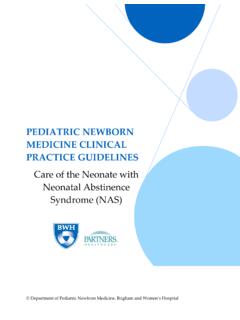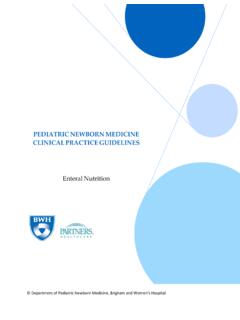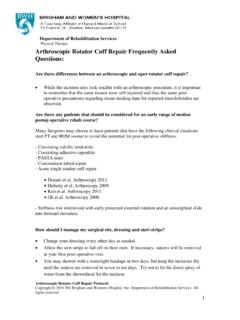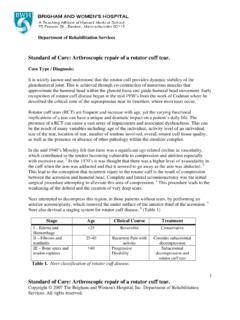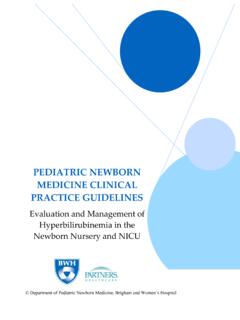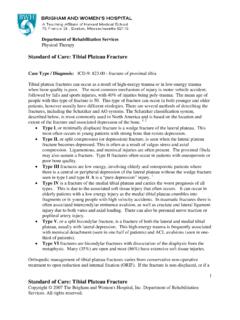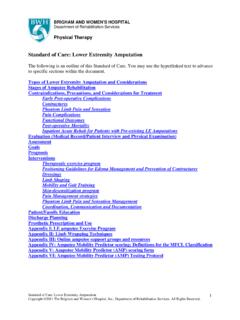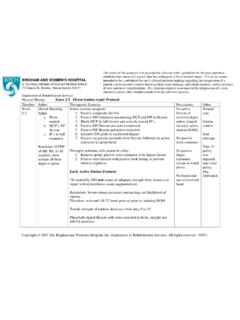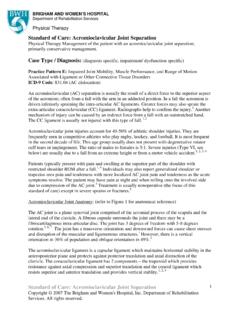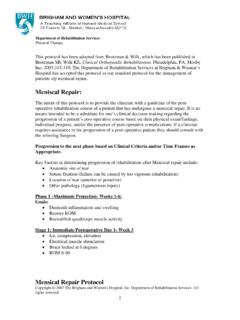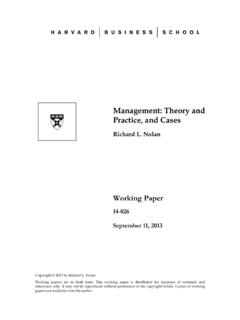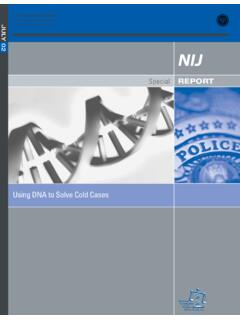Transcription of Arthroscopic Labral Repair Protocol, II, IV, and complex tears
1 Arthroscopic Labral Repair (types II,IV and complex tears ) protocol : Copyright 2016 The Brigham and Women's Hospital, Inc. Department of Rehabilitation Services. All rights reserved. 1 This protocol has been adopted from Brotzman & Wilk, which has been published in Brotzman SB, Wilk KE, Clinical Orthopeadic Rehabilitation. Philadelphia, PA: Mosby Inc; 2003. The Department of Rehabilitation Services at Brigham & Women s Hospital has accepted a modification of this protocol as our standard protocol for the management of patient s s/p Arthroscopic Repair of Type II and IV SLAP lesions. Arthroscopic Labral Repair protocol -Type II, IV, and complex tears : The intent of this protocol is to provide the clinician with a guideline of the post-operative rehabilitation course of a patient that has undergone an Arthroscopic Labral Repair . It is no means intended to be a substitute for one s clinical decision making regarding the progression of a patient s post-operative course based on their physical exam/findings, individual progress, and/or the presence of post-operative complications.
2 If a clinician requires assistance in the progression of a post-operative patient they should consult with the referring Surgeon. If patient has a concomitant injury/ Repair (such as a rotator cuff Repair ) treatment will vary- consult with surgeon. Type I SLAP lesions consist of degenerative fraying of the superior labrum but the biceps attachment to the labrum is intact. The biceps anchor is intact. Type II SLAP lesions are created when the biceps anchor has pulled away from the glenoid attachment. Type III SLAP lesions involve a bucket-handle tear of this superior labrum with an intact biceps anchor. Type IV SLAP lesions involve a bucket-handle tear of the superior labrum in which the tear extends into the biceps tendon. The torn biceps tendon and labrum are displaced into the joint. complex SLAP lesions involve a combination of two or more SLAP types, usually II and III or II and IV. Repair of Type II SLAP Lesion1: Generally the superior labrum should be reattached to the glenoid and the biceps anchor stabilized.
3 Overhead-throwing athletes with this lesion often present with the biceps tendon detached from the glenoid rim. Peel-back lesions are also commonly seen. When developing a rehabilitation program it is important to determine the extent of the lesion, as well as the location and number of sutures. Department of Rehabilitation Services Physical Therapy Arthroscopic Labral Repair (types II,IV and complex tears ) protocol : Copyright 2016 The Brigham and Women's Hospital, Inc. Department of Rehabilitation Services. All rights reserved. 2 Repair of Type IV SLAP Lesion1: Similar to Type II Repair ; however, will involve biceps Repair , resection of frayed area or tenodesis. Rehabilitation is similar to that for Type II Repair except for biceps activity. Timeframes for active and resisted biceps activity will vary depending on the extent of bicipital involvement. Consultation with the surgeon regarding the progression of biceps activity based on the integrity of the biceps tendon Repair is required.
4 In cases where the biceps is resected, biceps muscular contractions typically may begin between six and eight weeks post surgery In cases of Repair to biceps tears or biceps tenodesis, no resisted biceps activities is typically advised for three months following surgery. Light isotonic strengthening for elbow flexion is initiated between weeks 12 and 16 postoperatively (in cases with a biceps tenodesis surgeon and therapist may choose to wait until 16 weeks to begin). Full resisted biceps activity is not initiated until post op weeks 16 to 20. Progression to sport-specific activities, such as plyometrics and interval sport programs, follows similar guidelines to those outlined for Type II SLAP repairs Phase I- Immediate Post Surgical Phase "protected motion" (Day 1-week 6) Goals: Protect the anatomic Repair Prevent/minimize the side effects of immobilization Promote dynamic stability Diminish pain and inflammation Post op day # 1 to Week 2 Sling for 4 weeks Sleep in sling for 4 weeks Wrist/ Hand active range of motion (AROM)/ Active Assisted Range of Motion (AAROM) Hand-gripping exercises PROM/AAROM: -Flexion and elevation in the plane of the scapula to 60 (week 2, flexion to 75 ) -External rotation(ER)/internal rotation (IR) with arm in scapular plane -ER to 10 -15 -IR to 45 No AROM ER, extension, or abduction Submaximal isometrics for all rotator cuff, periscapular, and shoulder musculature No isolated biceps contractions (i.)
5 E. no active elbow flexion) Cryotherapy, modalities as indicated Arthroscopic Labral Repair (types II,IV and complex tears ) protocol : Copyright 2016 The Brigham and Women's Hospital, Inc. Department of Rehabilitation Services. All rights reserved. 3 Weeks 3-4 Discontinue use of sling at 4 weeks Continue gentle PROM/AAROM exercises (Rate of progression based on patient s tolerance) o Flexion and elevation in the plane of the scapula to 90 o Abduction to 75-85 o ER in scapular plane to 25-30 o IR in scapular plane to 55-60 No AROM ER, extension, or elevation Initiate rhythmic stabilization drills within above ROM Initiate proprioceptive training within above ROM Progress isometrics as above Continue use of cryotherapy, modalities as indicated Weeks 5-6 Begin AROM of shoulder (all planes, gravity eliminated positions then gravity resisted position once adequate mechanics): Gradually improve PROM and AROM o Flexion and elevation in the plane of the scapula to 145 o Abduction to 145 o External rotation 45-50 at 45 abduction o Internal rotation 55-60 at 45 abduction o Extension to tolerance May initiate gentle stretching exercises Gentle Proprioceptive Neuromuscular Facilitation (PNF) manual resistance Initiate prone exercise program for periscapular musculature Begin AROM elbow flexion and extension NO biceps strengthening Phase II.
6 Intermediate Phase-Moderate Protection Phase (Weeks 7-14) Goals Gradually restore full AROM and PROM (week 10) Preserve the integrity of the surgical Repair Restore muscular strength and balance Weeks 7-9 Gradually progress P/AROM o Flexion, elevation in the plane of the scapula, and abduction to 180 o External rotation 90-95 at 90 abduction o Internal rotation 70-75 at 90 abduction o Extension to tolerance Begin isotonic rotator cuff, periscapular, and shoulder strengthening program Arthroscopic Labral Repair (types II,IV and complex tears ) protocol : Copyright 2016 The Brigham and Women's Hospital, Inc. Department of Rehabilitation Services. All rights reserved. 4 Continue PNF strengthening Initiate "Thrower's Ten" program except resisted biceps exercise (see protocol ) Type II repairs: begin sub maximal pain free biceps isometrics Type IV, and complex repairs: continue AROM elbow flexion and extension, no biceps isometric or isotonic strengthening Weeks 10-12 Progress ER P/AROM to thrower's motion o ER 110-115 at 90 abduction in throwers (weeks 10-12) Progress shoulder isotonic strengthening exercises as above Continue all stretching exercises as need to maintain ROM.
7 Progress ROM to functional demands ( , overhead athlete) Type II repairs: begin gentle resisted biceps isotonic strengthening @ week 12 Type IV, and complex repairs: begin gentle sub maximal pain free biceps isometrics Criteria for Progression to Phase III Full non painful ROM Good stability Muscular strength 4/5 or better No pain or tenderness Phase III: Minimal Protection Phase (weeks 14-20) Goals Establish and maintain full ROM Improve muscular strength, power, and endurance Gradually initiate functional exercises Weeks 14-16 Continue all stretching exercises (capsular stretches) Maintain thrower's motion (especially ER) Continue rotator cuff, periscapular, and shoulder strengthening exercises Type II repairs: progress isotonic biceps strengthening as appropriate Type IV, and complex repairs: progress to isotonic biceps strengthening as appropriate "Thrower's Ten" program with biceps exercise or fundamental exercises PNF manual resistance Endurance training Initiate light plyometric program Restricted sports activities (light swimming, half golf swings) Weeks 16-20 Continue all exercises listed above Continue all stretching Arthroscopic Labral Repair (types II,IV and complex tears ) protocol : Copyright 2016 The Brigham and Women's Hospital, Inc.
8 Department of Rehabilitation Services. All rights reserved. 5 Continue "Thrower's Ten" program Continue plyometric program Initiate interval sport program ( throwing). See interval throwing program Criteria for Progression to Phase 4 Full non painful ROM Satisfactory static stability Muscular strength 75-80% of contralateral side No pain or tenderness Phase IV: Advanced Strengthening Phase (Weeks 20-26) Goals Enhanced muscular strength, power, and endurance Progress functional activities Maintained shoulder stability Weeks 20-26 Continue flexibility exercises Continue isotonic strengthening program PNF manual resistance patterns Plyometric strengthening Progress interval sports programs Phase V: Return to Activity Phase (Months 6-9) Goals Gradually progress sport activities to unrestrictive participation Continue stretching and strengthening program Formatted 5/06 Ethan Jerome, PT. Reviewed Reg B. Wilcox III, PT; 5/2016 1 Wilk K, et all.
9 Current Concepts in the Recognition and Treatment of Superior Labral (SLAP) Lesions. JOSPT 2005;35:273-291.
